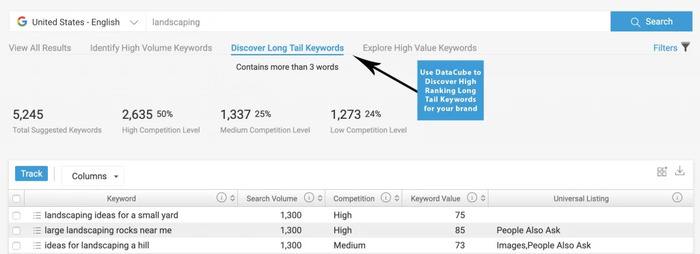What is content marketing?
Content marketing is a valuable digital tool for building a brand and meeting the needs of the modern customer to both gain and keep their attention online. It has grown incredibly over the past few years.
Content marketing has dominated digital marketing efforts for the past decade as brands have become more adept at attracting prospective customers through engagement online. As the industry has matured, brands have begun to better understand users’ online behavior, thus empowering them to create strong sales funnels and integrate content marketing more thoroughly with the rest of their marketing strategy.
As marketers delve deeper than the surface understanding of keyword optimization and user intent, they often find themselves running into new questions. We have brought together some of the most common questions we have received to create an advanced content marketing guide.
What do long-tail keywords vs medium-tail vs short-tail keywords mean?
There has been some buzz lately surrounding different types of keywords, namely short-tail keywords versus long-tail keywords versus medium-tail or torso keywords. Beginning a few years ago, people began to discuss the importance of long-tail keywords while working on content marketing.
 Marketers generally understood that short-tail or head-term keywords, like health, lawyer, real estate, insurance, travel, etc. had become overly competitive on both a paid and organic basis. Not only were too many websites trying to gain top ranking results on these keywords, but in instances of local SEO, these keywords could even end up attracting people to the site who likely would never be customers in that local area. If an organic restaurant in Tucson, for example, ranks highly for “restaurant” and attracts traffic searching for a place to eat in Toledo, this traffic would provide them with little financial benefit.
Marketers generally understood that short-tail or head-term keywords, like health, lawyer, real estate, insurance, travel, etc. had become overly competitive on both a paid and organic basis. Not only were too many websites trying to gain top ranking results on these keywords, but in instances of local SEO, these keywords could even end up attracting people to the site who likely would never be customers in that local area. If an organic restaurant in Tucson, for example, ranks highly for “restaurant” and attracts traffic searching for a place to eat in Toledo, this traffic would provide them with little financial benefit.
This then leaves long-tail keywords and medium-tail keywords. Both of these types of keywords include additional words that provide context for the keyword, helping brands to more accurately target their audience and increase their chances of ranking well for their content marketing efforts. For example, for our restaurant above, the keyword “organic restaurant in Tucson” would provide them with far superior traffic. The main difference between ‘medium’ and ‘long-tail’ lies in simply how many words are included in the keyword phrase.
Long-tail keywords are generally understood as containing three or more words, whereas medium-tail keywords have more like two to three words. This is an important note for proper content marketing. The goal with the medium-tail keyword is to maximize the audience for the keyword while not compromising the level of precision and still increasing the chances of ranking well for the phrase and attracting the right audience.
Many people will not even make this distinction between types of keywords, often referring to them all as long-tail keywords. On the BrightEdge platform, for example, we often suggest long-tail keywords, but some of the suggestions often contain only two to three words, which could be considered medium-tail keywords for those who prefer to differentiate.

Should I delete or redirect pages that do not get strong traffic? How will this impact SEO?
When it comes to auditing your site while implementing a content marketing strategy, you will likely discover that some pages do not get much traffic and have little importance from an SEO standpoint. When this happens, we often have customers ask us if it would be worth deleting these particular pages; if taking this step would help or hurt their SEO.
In generally, we find that yes, redirecting these poorly engaging pages can be helpful for content marketing and SEO if they have any internal or external links. One, it helps to reduce the potential for pages competing for the same or similar keywords. It also reduces index bloat and helps to ensure that the Google algorithm focuses on the pages for mobile and desktop that have the most value for your site and your prospective customers.
To do this content marketing strategy successfully, however, brands need to make sure that they set it up correctly. This means looking for content that has not been needed in at least a year. You want to make sure your content marketing plan targets only pages with low views and no rankings of value. Use a 301 redirect to do this.
When looking at this potentially deletable content, you also want to check if the content could potentially be updated and if it might then offer value for prospective customers. The first priority for this content marketing step should be to update content when possible, as it will have the advantage of being and established page. If the content has no value, however, then it should be redirected.
When you want to exclude content, make sure that you always set up a 301 redirect, even if no one has visited the page in years. Deleting any page on your site without setting up a 301 has the potential to create a very poor user experience, and if Google detects it, it will definitely hurt the reputation of the site with a potential 404 error.
Make sure that the 301 redirect takes people to another page that is related to the deleted page. Taking people to the homepage will hurt the user experience of anyone who lands on the redirect. Instead, try your best to understand what their user intent may have been if they sought out the deleted page and redirect them to content that will help them and your content marketing efforts.
How often should I refresh my content?
The art of refreshing content also frequently comes up for customers who want to better manage their online material and content marketing. Content that was published years ago tends to not garner as much attention from customers or search engines, both of whom assume that the material is out-of-date and thus offers little value. Given the demands on brands to continually publish new material, however, finding the time to constantly refresh old content can feel like a burden.
What we suggest for is this:
- Look for content that is older than two to three years or deals with material that has otherwise gone through a public update. Spend maybe two hours per week refreshing this type of material. If that content marketing topic has changed drastically enough to warrant publishing new content, add a link so that people can see the updated piece if they land on the older one.
- If you need to delete content because it has become so outdated that a simple refresh will not suffice for your content marketing strategy, make sure you add a 301 redirect. Do not let your users find a 404 error for any reason.
- Use the BrightEdge platform to regularly see the recommendations for all the pages on your site. As you follow these recommendations, many pages will naturally be updated with the latest SEO best practices.
How should I stop keyword cannibalization?
With marketers perpetually producing a stream of content, keyword competition often arises within a site. Understanding the potential dangers that can occur from this situation--known as keyword cannibalization, however, makes it clear why brands generally want to avoid this practice while executing on content marketing.
When keyword competition does not disrupt the ranking of your pages, generally, it is not something to become terribly worried about. Sometimes, however, brands might find that during content marketing, they accidentally rank lower quality pages higher than their targeted pages. For example, they might find a blog post ranks higher than a high-performing landing page. This can disrupt conversion rates.
Lower quality pages can also damage brand reputation as it might be the first interaction with your brand that a particular customer has. It will also result in you being your own competitor, with your own site hindering your click through rates.
To combat this keyword cannibalization during content marketing practices, generally, we recommend:
- Saving your highest-value keywords for your targeted content and focusing on alternates for non-converting pages
- If you find that keyword cannibalization has already occurred, consider restructuring the pages to make the higher ranking page better reflect your brand and offer opportunities for conversion
- If this cannot be done, consider deoptimizing the page by removing keywords from title tag and H1 and reworking the text to adjust the optimization of the page you do not want ranked higher
- If nothing else works, delete the page that cannibalizes the content and redirect people to the preferred page. If you resort to this measure, verify that your 301 has been set up correctly, as it will directly impact the success of a high-conversion page.
Content marketing continues to play a critical role in site development and optimization. As brands begin to develop strategies and dive deeper into this form of marketing, however, they may find themselves plagued with questions pertaining to particular situations that arise. Review these ideas in our advanced content marketing ebook to see if they help you better understand the next level of content marketing.
